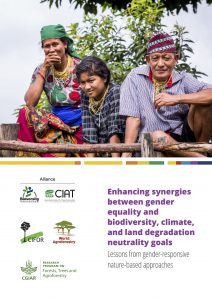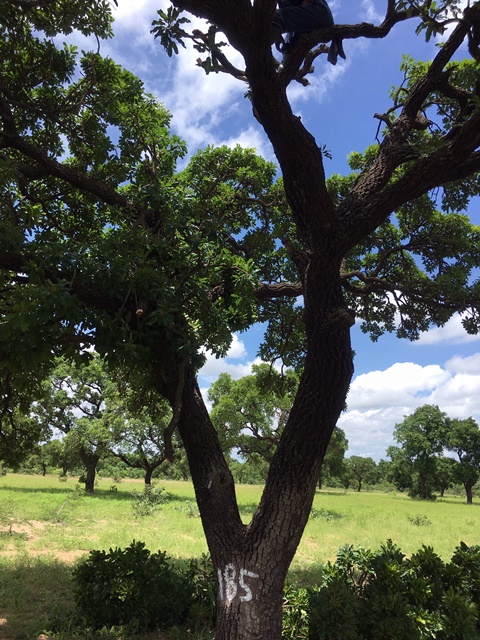Nature-based solutions can play a crucial role in solving the interconnected crises of climate change, biodiversity loss and land degradation – but their full potential will only be fulfilled if they are designed to address gender inequality.
That was the main takeaway from a new paper published by the Alliance of Bioversity International and the International Center for Tropical Agriculture (CIAT), one of FTA’s managing partners.
Land use decisions can generate synergies to address issues such as climate and biodiversity at the same time, the paper finds, and these decisions are influenced by social dynamics such as gender relations, which affect how the benefits of nature-based solutions are distributed within and across households, communities, and beyond.
To maximize these synergies and an equitable distribution of benefits, the paper calls for gender-responsive approaches that address the priorities and concerns of women and other marginalized groups, enhance their capacities, and facilitate their involvement in land use decision-making.
Three steps toward more equitable land use
“If we ignore power relations around who captures the benefits and plan interventions without thinking carefully about how resources are allocated and who participates, we run the risk of elite capture,” says Marlène Elias, the lead author of the paper. “It’s important to carry out a careful analysis of tenure and power relations among community members to prevent this elite capture.”
The first step toward addressing these inequities is to recognize the legitimate stakes, claims, and rights that different groups, such as rural women and men of different ages, socio-economic status, ethnicity, etc., have in/to restoration.
Once these groups have been recognized, it follows that they should have a voice in key decisions that affect them through their effective representation and participation in environmental management initiatives. Initiatives should safeguard their rights through measures such as grievance mechanisms and free, prior and informed consent.
Finally, practitioners must ensure that the costs and benefits of an initiative are equitably distributed. Costs may include labor, management and transaction costs, while benefits may be either direct, such as payments for planting trees, or indirect, such as those derived from ecosystem services.
“For example, if you’re not looking carefully at how labor is allocated within households, then women with land management and agricultural responsibilities could end up putting in labor without benefiting from it,” Elias explains.
“The benefits might instead be directed to heads of household, who tend to be predominantly men in most of the contexts we work in.”
Designing equitable nature-based solutions
Nature-based approaches are not inherently equitable – and they must be intentionally designed with gender and inclusion issues in mind, the authors emphasize.
For instance, collaborative forest management (CFM) can promote synergies by promoting forest conservation and restoration, combating biodiversity loss, deforestation and land degradation, and sequestering carbon at the same time. However, CFM can create these synergies even more effectively if it also enhances gender equality, such as by increasing women’s influence over forest management decisions and improving their access to forest resources. The paper cites several studies showing that women’s participation in forest management can be positively linked with both forest growth and carbon sequestration, with mixed-gender groups being linked with greater community compliance with rules on resource use.
Existing social hierarchies and norms often prevent marginalized groups from participating in and benefiting from CFM. Hence, approaches such as Adaptive Collaborative Management – a collective problem-solving approach – have been developed to address these exclusions by recognizing women and other marginalized groups as key stakeholders in forest management. Practitioners can improve the representation and participation of these groups in CFM by harnessing their unique knowledge and expertise, the authors suggest.
Another notable example is the U.N.’s Reducing Emissions from Deforestation and Forest Degradation (REDD+) initiative, which aims to reduce global greenhouse gas emissions by sequestering carbon through forest restoration and reforestation. REDD+, which FTA has covered extensively as part of its flagship research on climate mitigation and adaptation, rewards individuals financially for conserving and sustainably using forests based on verified emissions reductions, and creates synergies by simultaneously combating climate change, deforestation, forest degradation and biodiversity loss, while also contributing to socioeconomic development.
Gender-responsive REDD+ can further improve these outcomes by incentivizing women and other marginalized groups to support, conservation, restoration and reforestation efforts. It must recognize that such groups will be disproportionately affected by the impacts of climate change on the one hand, but that they are also valuable agents of change in climate action on the other hand.
Yet recognition is not enough to ensure that the benefits of REDD+ are equitably distributed. Formal measures such as secure land tenure rights are crucial to enabling women to benefit from these scheme, as women’s rights to land and other natural resources are often mediated by male relatives.

“The cases demonstrate that we should not assume that women’s representation in environmental initiatives alone will result in more equitable decision making and benefits,” the paper concludes.
“Gender-responsive policy will need to safeguard the rights of women and marginalized groups, strengthen their capacities to exercise leadership and influence environmental agendas, and ensure that they reap the benefits, and not only the costs and burdens, of environmental change.”
Read more on FTA’s research on gender:
- A Feminist approach to Restoration – Interview with Marlène Elias
- Restoration for Whom, by Whom? A Feminist Political Ecology of Restoration
- Women producers in Burkina Faso face hardship if shea industry dwindles
- Making space for women and Indigenous Peoples at the decision-making table
- Enhancing women’s resource rights for improving resilience to climate change
- Brief on a post-2020 gender-responsive global biodiversity framework
This article was written by Ming Chun Tang.
This article was produced by the CGIAR Research Program on Forests, Trees and Agroforestry (FTA). FTA is the world’s largest research for development program to enhance the role of forests, trees and agroforestry in sustainable development and food security and to address climate change. CIFOR leads FTA in partnership with ICRAF, the Alliance of Bioversity International and CIAT, CATIE, CIRAD, INBAR and TBI. FTA’s work is supported by the CGIAR Trust Fund.













